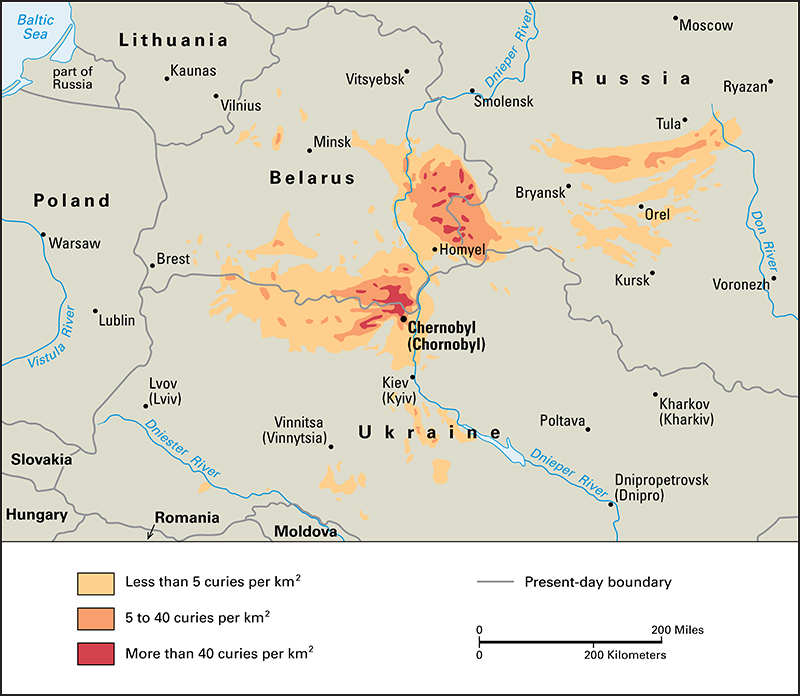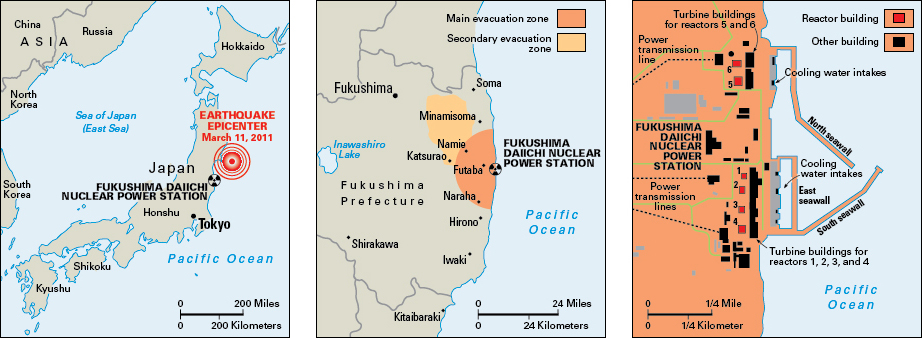Fallout is radioactive material that settles over Earth’s surface following a nuclear explosion. Fallout can also be released by a nuclear reactor as part of an accident. Some of the material consists of atoms known as radioactive isotopes or radioisotopes. These isotopes form from the fission (splitting) of uranium or plutonium in a nuclear weapon or reactor. Radioisotopes also form when radiation that results from an explosion causes other atoms nearby to become radioactive.
After an explosion or accident, the radioisotopes in the air, on the ground, and in the bodies of living things decay (break down) into more stable isotopes. They do so by emitting radiation in the form of alpha particles, beta particles, and gamma rays. Exposure to large amounts of this radiation can result in immediate sickness and even death. Exposure to this radiation over longer periods can cause cancer and damage genes.
The testing of nuclear weapons in the atmosphere once produced large amounts of fallout. Today, fallout from aboveground testing has been eliminated by underground testing. However, a serious accident in a nuclear reactor can also create fallout.
How fallout is produced.
Nuclear explosions produce a giant fireball of intensely hot gases and dust. Everything inside the fireball or in contact with it is vaporized (turned into a gas). When an explosion occurs close to Earth’s surface, the fireball vaporizes soil, vegetation, and buildings. The intensely hot gases of the fireball also draw in dirt, dust, and other small particles as the fireball rises into the atmosphere. The radioisotopes formed during fission then combine with the vaporized materials. As the vaporized materials rise and cool, some of them condense into solid particles ranging in size from fine invisible dust to ashes the size of snowflakes. These particles, to which radioisotopes have become attached, fall to Earth, thus the term fallout.
How fallout is distributed.
The time it takes fallout particles to settle out of the atmosphere and reach Earth and the distance they travel from the point of origin depend on several factors: (1) the force of the explosion, (2) the particles’ size and composition, (3) the altitude they reach before they start to fall, (4) the pattern of winds that carry them, (5) the latitude at which the release of radioisotopes occurs, and (6) the time of year.
The larger or heavier fallout particles settle near where they are released in an irregularly shaped area, depending on the winds that carry them. In general, the intensity of radiation decreases as the distance from the point of origin increases. But areas of intense radioactivity called hot spots may be scattered within the zone of fallout. Hot spots occur when rain, snow, or other precipitation washes fallout particles out of the atmosphere.
The smaller particles of fallout may be scattered by winds to distant parts of the world. Winds traveling through the troposphere, the lowest layer of the atmosphere, carry some fallout for a few days to a few weeks. Winds near Earth’s surface often change their direction. But in the upper troposphere, winds generally blow in an eastward direction. Fallout carried to this height circles Earth within a week or two. Most of the fallout drops in a band around Earth near the latitude of the fallout’s origin.
In the most powerful nuclear explosions, much of the fallout may rise to the stratosphere, the layer of atmosphere above the troposphere. There, fallout becomes widely scattered and may take from several months to several years to return to Earth’s surface.
The fallout hazard.
Fallout can be dangerous to plants, animals, and people because of the radioactive elements it contains (see Radiation sickness). These radioactive elements include about 200 isotopes of more than 30 chemical elements produced by a nuclear explosion.
Different radioisotopes in fallout give off radiation for different periods. Most fallout decays into more stable isotopes in a matter of hours or days. As a result, the radioactivity at the end of two weeks is only one-thousandth as strong as the radioactivity one hour after the nuclear explosion. A few of the fallout elements continue to give off radiation over a long period. For example, the radioisotope strontium 90 loses half its radioactive strength every 28 years, and the radioisotope cesium 137 loses half its strength every 30 years. See Radiation (Radiation and radioactivity).
Exposure to radiation created by fallout occurs mainly in two ways. The first type of exposure results from radioactive particles and debris on the ground. People can protect themselves from this direct radiation by taking refuge in underground fallout shelters or by staying indoors. A covering of soil or the walls of a building provide protection from fallout.
Second, fallout can enter the body through air, food, or drinking water contaminated by radioisotopes. Normally, radioactive particles do not remain airborne long. Thus, contaminated air is only hazardous for a short time. The transfer of radiation through food occurs over longer periods. A common pathway for the transfer of radioisotopes is through milk. This transfer begins when fallout settles on grass and cows eat the grass. Some of the radioisotopes are then transferred to the cow’s milk. Anyone who drinks the contaminated milk takes in iodine 131, which collects in the thyroid; strontium 90, which is absorbed by the bones; or cesium 137, which is retained in muscle or other tissues. Foods are also contaminated by the direct deposit of fallout on plants and by the slow uptake of radioisotopes in soil by the roots of plants.
History.
From the mid-1940’s to the early 1960’s, the United States, the Soviet Union, and a few other nations exploded many experimental nuclear weapons. As a result, fallout increased to alarming levels. In 1963, more than 100 nations, including the United States and the Soviet Union, signed a treaty that banned the testing of nuclear weapons everywhere but underground. Fallout then decreased greatly. China and France did not sign the treaty. But they later stopped testing nuclear weapons aboveground.
Today, accidents at nuclear reactors pose the greatest risk of fallout. In 1986, an accident occurred at the Chernobyl (now Chornobyl) nuclear power plant in Ukraine, which was then part of the Soviet Union. It created fallout consisting mainly of the radioisotopes iodine 131 and cesium 137. A power surge caused fuel in the nuclear reactor to overheat, resulting in a steam explosion and fire. The radioisotopes created by nuclear fission in the reactor escaped into the atmosphere through the smoke from the fire, which burned for 10 days.

The fallout from the Chernobyl accident was distributed by winds. However, the majority of the debris remained in the troposphere. Areas that sustained the highest levels of radioactive deposits were in northwest Ukraine, southeast Belarus, and southwest Russia. In addition, precipitation created hot spots throughout the zone of fallout. Radioactive isotopes were carried into northern and central Europe. Traces of radioactivity were eventually measurable throughout the Northern Hemisphere.
The explosion at Chernobyl was the worst nuclear accident in history, but other serious accidents have also occurred. One of the worst accidents happened at the Windscale plutonium production plant in northern England in 1957. Fallout from a fire in a reactor at the Windscale plant contaminated about 200 square miles (520 square kilometers) of surrounding countryside. In the United States, an accident occurred at the Three Mile Island nuclear power plant near Harrisburg, Pennsylvania, in 1979. Overheating caused by an interruption in the reactor’s cooling system resulted in severe damage to a reactor core. However, a protective building that contained the reactor largely prevented the radioactive debris from being released into the environment. In 2011, the Fukushima Daiichi Nuclear Power Station in Japan released about 10 to 20 percent as much fallout as did the Chernobyl disaster. A tsunami wave produced by an earthquake had damaged the complex, resulting in overheating and steam explosions. 
See also Chernobyl disaster; Civil defense; Isotope; Japan earthquake and tsunami of 2011; Nuclear energy (Safety concerns); Nuclear weapon; Nuclear testing; Radiation (Effects of radiation); Three Mile Island.
